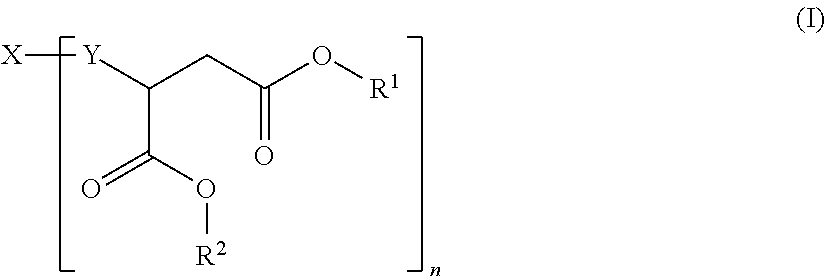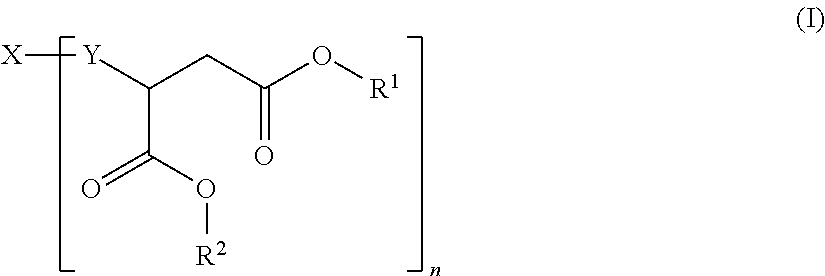Hydrophilic polyaspartic esters
a technology esters, which is applied in the field of hydrophilic polyaspartic esters, can solve the problems of unsuitability for the majority of coating applications
- Summary
- Abstract
- Description
- Claims
- Application Information
AI Technical Summary
Benefits of technology
Problems solved by technology
Method used
Image
Examples
example 1
Inventive
[0094]900 g (3.26 mol) of the polyamine component A1) were introduced under dry nitrogen at a temperature of 40° C. as an initial charge, 100 g (0.27 eq) of the polyisocyanate component BI) were added, corresponding to an equivalents ratio of NH:NCO of 12.0:1, and the mixture was stirred for approximately 2 hours until the isocyanate band (at around 2270 cm−1) had disappeared completely from the IR spectrum. The clear polyaspartic ester of the invention, light in colour, had the following characteristic data:
Amine number: 166 mg KOH / g
Equivalent weight: 337 g / eq NH
Viscosity (23° C.): 1400 mPas
Colour number (APHA): 30 Hazen
[0095]300 g of this polyaspartic ester were introduced into a glass beaker, admixed with 200 g of deionized water and converted by simply stirring with a magnetic stirrer into a stable aqueous dispersion having a solids content of 60%. The average particle size was 144 nm.
example 2 to 11
Inventive
[0096]In accordance with the process described in Example 1, the polyamine components A1) and A2) were reacted with the polyisocyanate components B1) to B6) to form hydrophilic polyaspartic esters of the invention. Table I hereinafter shows the compositions of the reaction batches (parts by weight in each case) and also characteristic data for the hydrophilic polyaspartic esters of the invention obtained and for the aqueous dispersions of the invention obtained from the polyaspartic esters. The hydrophilic polyaspartic esters obtained in inventive Examples 2 to 11 were light in colour, as was the hydrophilic polyaspartic ester obtained according to Inventive Example 1. This is evident from the Hazen colour numbers measured (APHA) of 17 to 58 Hazen.
TABLE 1Example234567891011Polyamine component A1)80808575—————80Polyamine component A2)————8080808080—Polyisocyanate component B1)————20—————Polyisocyanate component B2)20————20————Polyisocyanate component B3)—201525——20———Polyiso...
example 12
Inventive
[0097]27 parts by weight of the hydrophilic polyaspartic ester of the invention from Example 8 were processed by the process described in Example 1 with 18 g of deionized water to give an aqueous 60% dispersion. 0.15 part by weight of BYK®-349 and 0.35 part by weight of BYK®-378 (silicone surfactants) were added, and then a solids content of 35% was set using a further 32.25 parts by weight of deionized water. Added to this batch were 13.6 parts by weight of an anionically hydrophilized HDI polyisocyanate marketed by Bayer MaterialScience (DE) under the designation Bayhydur® XP 2655 as a curing agent for aqueous 2K (2-component) polyurethane systems, having an NCO content of 21.2% and a viscosity (23° C.) of 3500 mPas, in the form of an 80% strength solution in 3-methoxy-n-butyl acetate (total amount of addition: 17.0 parts by weight) (corresponding to an equivalents ratio of isocyanate groups to amino groups of 1:1), and the mixture was homogenized by intensive stirring (2...
PUM
| Property | Measurement | Unit |
|---|---|---|
| temperature | aaaaa | aaaaa |
| hydrophilic | aaaaa | aaaaa |
| molecular weight | aaaaa | aaaaa |
Abstract
Description
Claims
Application Information
 Login to View More
Login to View More - R&D
- Intellectual Property
- Life Sciences
- Materials
- Tech Scout
- Unparalleled Data Quality
- Higher Quality Content
- 60% Fewer Hallucinations
Browse by: Latest US Patents, China's latest patents, Technical Efficacy Thesaurus, Application Domain, Technology Topic, Popular Technical Reports.
© 2025 PatSnap. All rights reserved.Legal|Privacy policy|Modern Slavery Act Transparency Statement|Sitemap|About US| Contact US: help@patsnap.com



